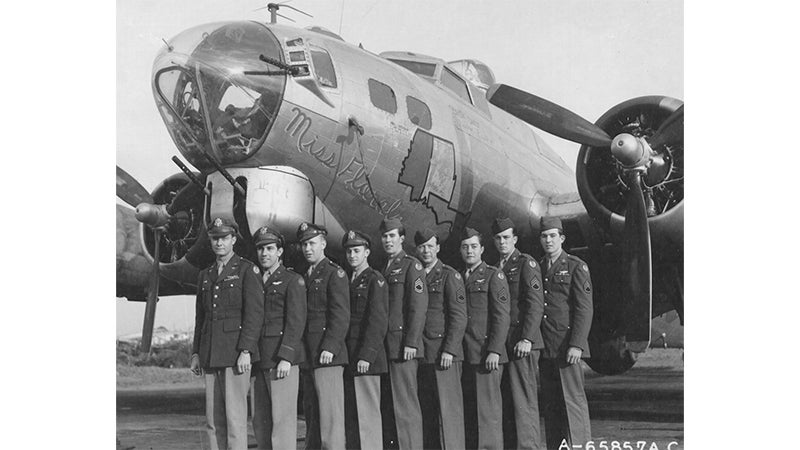One of the last B-17s lost in WWII “Miss Florala”
Published 1:30 pm Friday, September 9, 2022

- One of the early crews of the B-17, "Miss Florala." [Photo: The American Air Museum in Britain]
|
Getting your Trinity Audio player ready...
|
On April 8, 1945, B-17 44-6173, “Miss Florala,” was lost to flak over Germany. The nose art on the bomber showed the outline of the states of Mississippi, Florida and Alabama. We’re not sure why the name, “Miss Florala,” was chosen, but it seems reasonable to assume that one of her earlier crews was from those three states. The name and nose art can be seen in the accompanying photo.
The B-17 44-6173 was delivered to the 381st Bomb Group at Ridgewell, Essex, England, on June 28, 1944. Ridgewell was home to the 381st Bomb Group from June 1943 until June 1945. During that time, 296 missions were flown with a loss 131 B-17s. “Miss Florala” was the last plane to be lost by the 381st Bomb Group during WW II.
On April 8, 1945, “Miss Florala” took off for a bombing mission deep into Germany with 2nd Lt. Harvey E. Adelmeyer as her pilot. The rest of her eight-man crew were 2nd Lt. John W. Frampton, co-pilot; flight officer and navigator, Norman E. Melvin; flight engineer, T/Sgt. Richard L. Dailey; radio operator and top-turret gunner, T/Sgt. James H. Hayden; right waist-gunner, Sgt. Robert E. Cobb; tail gunner, Sgt. Edward P. Houser; and bombardier/togglier, S/Sgt. Edward D. Dybicz. Six of the eight-man crew would not return.
The following account of the loss of “Miss Florala” comes from Missing Air Crew Report [MACR] 13873. The report was filed using information from T/Sgt. James H. Hayden [the radio operator] and Sgt. Edward P. Hauser [the tail gunner], the only two surviving crew members.
The aircraft was over Stendahl, Sachsen-Anhalt, Germany, at approximately 12:15 pm local time, when it was hit by flak. Their bombs had just been dropped when the plane was hit by flak, causing the bomb bay door motor to catch fire. Late in the war, planes dropped bombs when the lead plane’s bombardier released his bombs. This was done by a toggle switch and the airman operating the switch was called a “togglier,” a combination of “toggle and bombardier.”
“Miss Florala’s” togglier was badly injured by the flak and was being assisted by the navigator. The co-pilot and flight engineer went forward to help the navigator. The co-pilot tried unsuccessfully to close the bomb bay doors but they remained stuck, half-open. The radio room was on fire so the pilot broke formation and dove the plane to 10,000 feet in an unsuccessful attempt to put out the fire.
The tail gunner came forward and kicked the waist door off which tore off part of the right rudder. By now, the fire had burned halfway through the radio room. The smoke had gotten worse and the tail gunner asked the waist gunner and the flight engineer if they would jump. They said no. At the same time the tail gunner was asking the radio operator if he would jump, the plane exploded, blowing the right wing off.
The tail gunner landed on his face by the door and bailed out. The radio operator was pulled out the door by the slipstream. He saw the engineer trying to get out but he didn’t make it. The tail gunner counted to eight, then opened his chute. The radio operator was right behind him.
While they were still about a thousand feet in the air, the Germans started firing at them. The tail gunner landed in a tree, slipped out of his parachute harness and dropped to the ground. All the while, the Germans were shooting into the tree. The radio operator landed some distance away. Neither were hit by the gunfire. The tail gunner took off his heated flying boots, put on his regular shoes and took off looking for the radio operator.
The two met at about 1:30 pm local time. The tail gunner, Sgt. Edward P. Houser, and the radio operator, T/Sgt. James H. Hayden, made a final statement, “The landing area was slightly south of Waake [east of Gottingen] and to our knowledge, we were the only two of the crew to get out. The plane came down about 1 ½ miles south of us.”
The two men gave their statement after they had been returned to base in England. In a twist of irony, none of the six crewmen killed in the crash were from Mississippi, Florida or Alabama.
The pilot, 2nd. Lt. Harvey E. Adelmeyer, was from Wisconsin; the co-pilot, 2nd. Lt. John W. Frampton, was from Minnesota; the navigator, Flight Officer Norman E. Melvin was from Maryland; the flight engineer and top turret gunner, T/Sgt. Richard E. Dailey was from Washington; the waist gunner, Sgt. Robert G. Cobb was from Missouri; and the togglier, S/Sgt. Edward J. Dybicz was from Illinois.
John Vick
The author would like to thank Charles Smith for telling him about the B-17 named “Miss Florala.”
Sources: Wikipedia; The American Air Museum in Britain, MACR 13873; b17flyingfortress.de; USAAF Nose Art Project.





